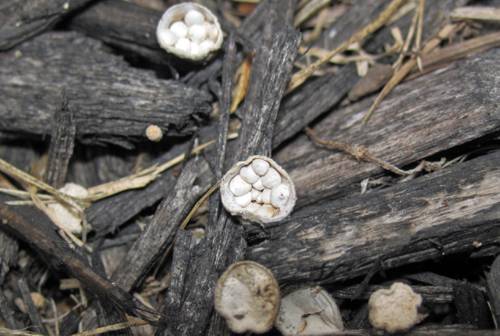
FAQ About Fungi and Indoor Plant Symbiosis

What is symbiosis between fungi and indoor plants?
Symbiosis between fungi and indoor plants is a mutually beneficial relationship where fungi and plants support each other's growth and survival. Fungi, often in the form of mycorrhizae, assist plants by improving nutrient absorption, particularly phosphorus. In return, the plant provides the fungi with carbohydrates produced through photosynthesis.

How do fungi benefit indoor plants?
Fungi benefit indoor plants primarily by enhancing nutrient absorption, increasing water uptake, and improving soil structure. This relationship helps plants grow more efficiently, promotes better root development, and can make plants more resilient to environmental stressors and diseases.

What types of fungi are commonly associated with indoor plants?
The most common type of fungi associated with indoor plants are mycorrhizal fungi, including arbuscular mycorrhizal fungi (AMF). These fungi form partnerships with plant roots to aid in nutrient uptake. Some indoor plants might also form symbiotic relationships with ectomycorrhizal fungi, though these are less common in indoor environments.

Can all indoor plants form symbioses with fungi?
Not all indoor plants form symbiotic relationships with fungi. Some plant species inherently lack the ability to pair with mycorrhizal fungi. However, many common indoor plants such as ferns, orchids, and certain houseplants like philodendrons and begonias do have this capability.

How do I introduce beneficial fungi to indoor plants?
To introduce beneficial fungi to indoor plants, you can use commercial mycorrhizal inoculants available in powder or liquid form. These products should be applied to the plant's root zone during planting or repotting. Ensure the soil is moist to help the fungi establish themselves effectively.

What environmental conditions support fungi and indoor plant symbiosis?
Fungi and indoor plant symbiosis is supported by moist soils, moderate temperatures, and well-aerated soil to encourage healthy root growth and fungal activity. Ensure your indoor plants receive adequate light and water, but take care to avoid waterlogged conditions that may hinder fungal growth.

Are there any signs that indoor plants have a healthy symbiosis with fungi?
Signs of a healthy symbiosis between indoor plants and fungi include lush green growth, robust root systems, improved plant vigor, and increased resistance to diseases and pests. Conversely, poor growth or unhealthy appearance may indicate issues with the symbiotic relationship or environmental factors affecting it.

Do fungi increase indoor plant growth speed?
Yes, fungi can accelerate the growth speed of indoor plants by enhancing nutrient and water uptake, thereby providing plants with more resources to support rapid growth. Mycorrhizal fungi improve the efficiency of resource use, which can lead to quicker establishment and overall growth.

Can harmful fungi affect indoor plant symbioses?
Yes, harmful fungi such as pathogenic molds and mildews can negatively impact indoor plant health and disrupt beneficial symbioses by outcompeting or otherwise affecting beneficial fungi. Maintaining good air circulation, proper humidity levels, and using well-draining soil can help minimize these risks.

What are mycorrhizal fungi?
Mycorrhizal fungi are a type of fungus that forms symbiotic relationships with plant roots. They play a crucial role in soil ecosystems by helping plants absorb nutrients like phosphorus and nitrogen more efficiently. In return, plants provide the fungi with carbohydrates needed for their metabolism.

How do mycorrhizal inoculants work for indoor plants?
Mycorrhizal inoculants work by introducing beneficial fungi to indoor plant soil, where they colonize plant roots and form mycorrhizae. These relationships enhance nutrient and water uptake, leading to improved plant health and growth. Inoculants are commonly applied during planting or repotting for maximum effectiveness.

Can indoor plant fungi be harmful to humans?
While most fungi associated with indoor plants are not harmful to humans, some can cause allergies or respiratory issues if spores are inhaled. It’s important to ensure good ventilation and handle indoor plant fungi responsibly, using gloves and face masks if necessary to minimize contact with spores.

Is it possible to overpopulate fungi in indoor plant soil?
While beneficial fungi like mycorrhizae enhance plant health, overpopulation of fungi is unlikely since the plant and environment regulate fungi growth. However, an imbalance can occur if conditions favor pathogenic fungi. It’s important to maintain balanced soil conditions to support healthy fungi levels.

Do fertilizers affect fungi and plant symbiosis?
Yes, the use of certain synthetic fertilizers, especially high-phosphorus fertilizers, can disrupt fungi and plant symbiosis by reducing the plant's need to form relationships with mycorrhizal fungi. Opting for organic fertilizers and reducing phosphorus levels can promote healthier symbiotic relationships.

What is the role of arbuscular mycorrhizal fungi in indoor plants?
Arbuscular mycorrhizal fungi (AMF) play a significant role in enhancing the nutrient uptake of indoor plants, particularly phosphorus. They form specialized structures within plant roots called arbuscules, allowing efficient exchange of nutrients and helping plants survive in nutrient-poor soils.

Can indoor plant symbiosis with fungi help reduce plant diseases?
Yes, a strong symbiotic relationship with fungi can enhance a plant’s disease resistance. Mycorrhizal fungi improve plant nutrition and root health, contributing to plant vigor and resilience against diseases and pests. This symbiosis can act as a natural defense mechanism for indoor plants.

How do I identify if indoor plants are not benefiting from fungal symbiosis?
Indoor plants not benefiting from fungal symbiosis may display symptoms such as stunted growth, pale or yellowing leaves, and poor root development. These signs might indicate an imbalance in soil conditions or the presence of harmful fungi that disrupt beneficial interactions.

Can fungi help indoor plants in low-light conditions?
Fungi can support indoor plants in low-light conditions by optimizing nutrient absorption, helping the plant survive despite reduced photosynthetic efficiency. While not a replacement for sufficient light, a symbiotic relationship can alleviate some stress associated with low-light environments.

Why might a symbiotic relationship fail between fungi and indoor plants?
A symbiotic relationship might fail due to factors such as poor soil conditions, excessive use of chemical fertilizers, improper watering, or presence of pathogenic fungi. Maintaining proper environmental conditions and avoiding factors that inhibit fungi can help ensure a successful symbiosis.

What are some common misconceptions about fungi and indoor plants?
A common misconception is that all fungi associated with plants are pathogenic. In reality, most fungi involved in symbiotic relationships are beneficial. Another misconception is that plants cannot survive without these relationships, but they can, although less effectively in certain conditions.
